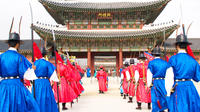Seoul City Private Full-Day Tour
Seoul, South Korea
Trip Type: Private Sightseeing Tours
Duration: 9 hours
The country of the morning calm is full of history and its capital, Seoul, abounds with authentic treasures. Join this 9-hour private tour to discover some of the most renowned gems of South Korean culture. From the great palaces to the N Tower, this tour will lead you through the ages to discover the old & the brand new capital.
More About This Activity All Private Sightseeing Tours →
The country of the morning calm is full of history and its capital, Seoul, abounds with authentic treasures. Join this 9-hour private tour to discover some of the most renowned gems of South Korean culture. From the great palaces to the N Tower, this tour will lead you through the ages to discover the old & the brand new capital.Your full day tour starts with a pick-up from your hotel at 9am with the following itinerary:
10am - Royal Guard Changing Ceremony
During the Joseon Dynasty, the royal guards performed the given task by guarding the Gwanghwamun Gate, the entrance of Gyeongbokgung Palace where the king ruled the country. Nowadays, comedian execute the reenactment ceremony but it's still very impressive.
10:15am - Gyeongbokgung Palace
Built in 1395, Gyeongbokgung Palace is also commonly referred to as the “Northern Palace” . It is arguably the most beautiful and remains the largest of all five palaces, with beautiful buildings such as Gyeonghoeru and Hyangwonjeong Pavilions which are both built on ponds. Please note: closed on Tuesdays. You will visit Changdeokgung Palace instead.
12pm - Bukchon Hanok Village
It sits between the two palaces of the Joseon Dynasty, Gyeongbokgung and Changdeokgung. Unlike other Hanok villages, Bukchon was not created for tourists but is actually a living village inhabited by Seoulites. The village is home to hundreds of traditional houses called ‘Hanok’ that date back to the Joseon dynasty.
1pm - Lunch
2pm - Insadong
Located in the heart of the city, it is an important place where old and precious and traditional goods are on display. There is one main road in Insa-dong with alleys on each side. Within these alleys are galleries, traditional restaurants, traditional tea houses, and cafes.
3pm - 63 Building or N Seoul tower
63 Building
With 63 floors measuring a height of 264m, this is Korea’s tallest and most recognized building. It offers a spectacular view of the Hangang River and the surrounding mountains of Bugaksan, Namsan and Gwanaksan.
N Seoul Tower
The N Tower, is where the clouds seem to meet with Namsan Mountain. The tower was built in 1969 on the highest point of Seoul so that visitors can enjoy the best panoramic views of the city. It was originally Korea’s first radio wave tower but has then been opened to the public in 1980, becoming a popular tourist attraction and a resting place for citizens.
4:30pm - Jogyesa Temple
Jogyesa Temple is the center of Zen Buddhism in Korea, and is famous for being located in the city. The first thing you will see at the temple are the trees. These locust trees and baeksong trees are about 500 years old.
The Daeungjeon building is a stately building built in 1938. It is particularly beautiful with all the different colors painted on it, and inside the building is the statue of Seokgamoni.
6pm - Drop-off at Hotel
10am - Royal Guard Changing Ceremony
During the Joseon Dynasty, the royal guards performed the given task by guarding the Gwanghwamun Gate, the entrance of Gyeongbokgung Palace where the king ruled the country. Nowadays, comedian execute the reenactment ceremony but it's still very impressive.
10:15am - Gyeongbokgung Palace
Built in 1395, Gyeongbokgung Palace is also commonly referred to as the “Northern Palace” . It is arguably the most beautiful and remains the largest of all five palaces, with beautiful buildings such as Gyeonghoeru and Hyangwonjeong Pavilions which are both built on ponds. Please note: closed on Tuesdays. You will visit Changdeokgung Palace instead.
12pm - Bukchon Hanok Village
It sits between the two palaces of the Joseon Dynasty, Gyeongbokgung and Changdeokgung. Unlike other Hanok villages, Bukchon was not created for tourists but is actually a living village inhabited by Seoulites. The village is home to hundreds of traditional houses called ‘Hanok’ that date back to the Joseon dynasty.
1pm - Lunch
2pm - Insadong
Located in the heart of the city, it is an important place where old and precious and traditional goods are on display. There is one main road in Insa-dong with alleys on each side. Within these alleys are galleries, traditional restaurants, traditional tea houses, and cafes.
3pm - 63 Building or N Seoul tower
63 Building
With 63 floors measuring a height of 264m, this is Korea’s tallest and most recognized building. It offers a spectacular view of the Hangang River and the surrounding mountains of Bugaksan, Namsan and Gwanaksan.
N Seoul Tower
The N Tower, is where the clouds seem to meet with Namsan Mountain. The tower was built in 1969 on the highest point of Seoul so that visitors can enjoy the best panoramic views of the city. It was originally Korea’s first radio wave tower but has then been opened to the public in 1980, becoming a popular tourist attraction and a resting place for citizens.
4:30pm - Jogyesa Temple
Jogyesa Temple is the center of Zen Buddhism in Korea, and is famous for being located in the city. The first thing you will see at the temple are the trees. These locust trees and baeksong trees are about 500 years old.
The Daeungjeon building is a stately building built in 1938. It is particularly beautiful with all the different colors painted on it, and inside the building is the statue of Seokgamoni.
6pm - Drop-off at Hotel
« Go Back

